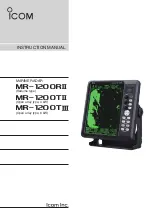
71
16. Solving Problem of Layer-by-Layer Determination of Groung
Thickness and Permittivity by CDP Technique in Flat Layer Model
Some General Information about the Technique
One of the main problems arising after a profile is taken relates to determination of
electromagnetic wave propagation velocity in layers (or determination of layers
permittivity).
Knowing the permittivity (or wave velocity) in the sounded medium layers is very
important, since it is the permittivity value that defines layer thickness determination
accuracy in data interpretation.
There are some more or less successful methods for estimating the wave propagation
velocities. One of those methods suggests using a synthetic hyperbola superimposed on the
path signal from a small-size target (menu option
Tools / Mouse action / Hyperbola
), or
Main Menu
button. This method however, has its limitations:
1.
You must have a profile with well discernible hyperbolic form signal and it is not
always the case.
2.
This method assumes sounded medium to be homogeneous, i.e. having constant
electromagnetic wave velocity in any point thereof; in reality this is not always the
rule, as the most media are layered.
One of the best known methods used for layer-by-layer velocities determination is
Common Depth Point
method (
CDP
) or
Common Mean Point
method (
CMP
). The idea
of this method is as follows: over a selected point sounding is performed, with both
antennas being equally spaced apart to opposite sides of the original position (see Fig.
14.1). Two separate antennas are used for transmitting and receiving signals, they are
sounding in a step mode receiving the signal at each discrete distance value between the
antennas. The path of reflected signal at such profile is known as hodograph. You are not
obligated to use two similar antennas for obtaining hodograph. In Zond-12e equipment, for
instance, it is possible to use a 500A antenna with a short cable for receiving (Rx), and a
300 MHz antenna with a long cable for transmitting (Tx).
T
R
medium 1
medium 2
medium 3
Fig. 16.1. Hodograph taking schematic. T - transmitting antenna; R - receiving antenna.
The following CDP acquisition guide could be used:
1.) Each shielded antenna system contains one transmitting and one receiving antenna;
2.) Here and below the antenna system called as unit, but the transmitting/receiving
antenna of each unit is called Tx/Rx antenna;
















































